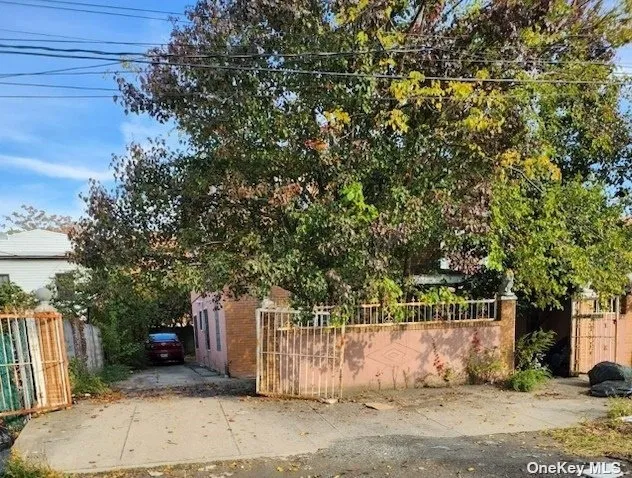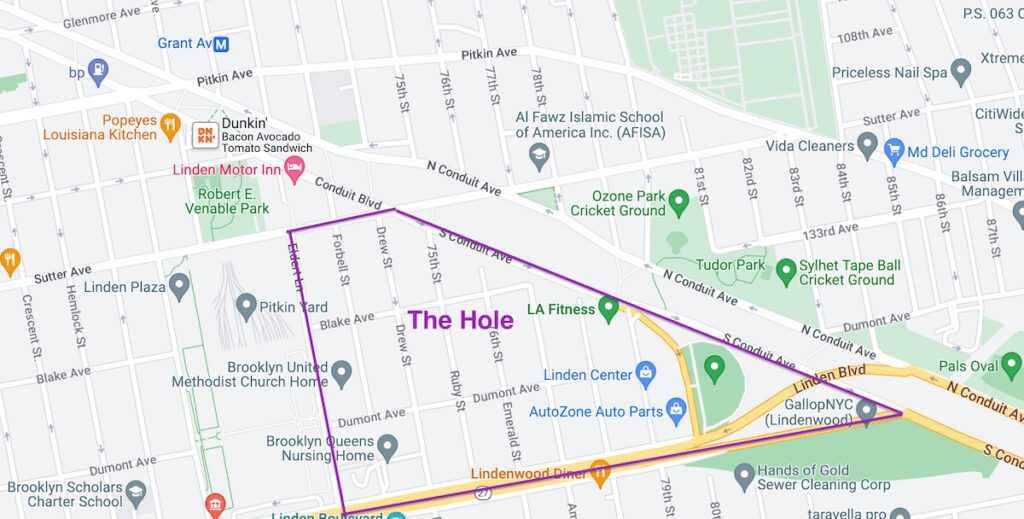A mysterious neighborhood on the Brooklyn-Queens border has a chaotic past and uncertain future. Once a dumping ground for the mob, it’s more currently known as cowboy stomping grounds and sinkhole vortex.
Take a wander down Emerald Street or any of the other gems in the area –Ruby, Amber, or Sapphire Street – and eventually, you’ll encounter it. Deep and wide, the waters are not clean. Some keep kayaks or rafts parked nearby to help cross if needed, while others just avoid it entirely. It’s called The Hole.
The Hole: Located Between Brooklyn and Queens
A strange fate sits at the end of the sparkly titled Jewel Streets, where normal pavement breaks down toward a deep, dark anomaly. The Hole is an enormous sinkhole that has come to dominate and shape the culture and livelihood of the small five-block neighborhood sitting on the Brooklyn Queens crossover. Aptly called “the closest thing New York has to a border town,” few willingly move to this area, and most who live there cannot afford to move out.
Don’t Forget Your Kayak
Residents have learned to adopt a lifestyle most never dream of. Frequent flooding of the area keeps the ambiance murky and mucky. The five-block radius of The Hole sits 30 feet below average land grade, and without any drainage system to run into, rainfall and other groundwater trickle and collect into the streets of The Hole, filling a pit with no drainage point. Bad rains can cause septic tanks in the area to join the overflow, creating a toxic and putrid waste zone.
Residents have used kayaks and rafts to navigate the expansive pools taking up their neighborhood blocks. Constantly flooded and increasingly run-down from lack of access, this Wild West scenario has been called a “lost” neighborhood. But was it always that way?
Spring Creek Pond to Sinkhole
The area forming The Hole was first officially owned by Jonathan Forbell and the Krats family, when a small pond occupied the northern part of the property connecting through stream Spring Creek of the south. The water in the pools comes from a mixture of rain and groundwater. The water table is situated so close to the surface that water is unable to drain, causing streets to remain flooded. While flooding was historically always an issue for this area, it became significantly worse once the city paved all the streets, restricting water drainage even further.
The homes of this neighborhood are not connected to New York City’s sewage system, mainly because the water table is too close to the ground level for gravity to allow the pipes to work properly. Residents living around The Hole use septic tanks and cesspools for their waste management, often to bad ends. This low-income neighborhood has little city support and many tanks have ruptured or leaked over the years, seeping into the ground below.
For decades there has been talk of change. Proposals for sewer systems and lifting streets have been addressed various times over the years, with no success. Eventually, the neighborhood fell further into disrepair than few could fathom.
The Federation of Black Cowboys
As if this Wild West tale isn’t wild enough, The Hole is also stomping grounds for both cowboys and horses. The Federation of Black Cowboys was formed in 1994 to “create greater understanding of African American culture and heritage” and does so through teaching and advocacy centered on Black involvement in American horse riding and ranching. The group formerly held residence in The Hole, where their horses were stabled in the area. Black Cowboys of New York City had a heyday in the 1980s, back when New York was home to the Black World Championship Rodeo, where cowboys gather to buck horses and catch steers.
“We still exist, we still go to schools and educate the youth on the legacy,” said Kesha Morse, the federation president, who added that the organization still keeps four horses stabled privately in Queens. “The mission was not to just have horses and ride horses; it was to educate.”
The group received scrutiny around 2013 when several horses died at a stable managed by the organization. The Federation had been in charge of and kept horses at Cedar Lane Stables in Howard Beach since 1998 but nearly lost access after 5 horses died in a relatively short period of time. It was later determined many of the deaths were caused by private owner negligence and were not to the fault of the federation. They have since gone back to normal operations. From sinkhole to mob graveyard to horses, what doesn’t exist here?
Chronicles of the Lost Neighborhood
There is no doubt just as much lore as there is reality. The isolation of The Hole gives good cover for those wanting to perform illegal activities or evade the law.
“There was a lot of wars down here. There a lot of places to hide. People did what they wanted to do,” said local Mr. Earle during an interview with the New York Times.
By sitting in between two police jurisdictions- the 106th Precinct in Queens and the 75th Precinct in Brooklyn- but with no passable through streets, the area is complicated for law enforcement to patrol or protect, and much goes unnoticed.
“Most people are here because they were born here or they can’t afford to live anywhere else,” said Ms. Watt, president of Jewel Streets Civic Association said. “I’d love to move, but I can’t afford to, so for now, I’m stuck in The Hole.”
The Bodies Began to Appear
Eventually, the pool started to shed its own secrets. Starting in the early 1980s, bodies began to emerge. Some were found by playing children, others by their scent, victims of mob crimes were slowly uncovered through The Hole.
A number of victims related to the crimes of mob boss John Gotti were discovered in the area. In 1981 children discovered a severed hand, eventually linked to the Bonnano crime family and Alphonse “Sonny Red” Indeilicato. Another two bodies were later found through an anonymous tipoff- this time belonging to Philip “Philly Lucky” Giaccone and Dominick “Big Trin” Trinchera.
One reason The Hole remains a high crime point is due to its jurisdiction and lack of access. Waterlogged roadways give no real pass-through for residents or police, making the area difficult to patrol and easy to hide in. These are not the only bodies to have been found, leaving many residents to feel their neighborhood is not safe. Luckily, nowadays, there are cowboys nearby to call upon.
Back in 2011, The Hole reached silver screen fame through two local filmmakers, Courtney Fathom Sell and Billy Feldman, who created a short 9-minute documentary called The Hole. Winning best documentary at the Red Hook International Film Festival, the video can be streamed online and gives voice to this strange and mythical land.
THE HOLE from Billy Feldman on Vimeo.
The Jewel Street Project
Yet with all the strife here, there are people who believe good can come of The Hole. A proposed 2024 building project estimated at around $37 million would raise the neighborhood grade, repave a number of roads and install a new storm drainage system that would reconnect the neighborhood to the city’s main sewer network.
“We’re all trying to work together to come up with a master plan for this whole neighborhood, and that’s been very complicated and very expensive,” Vincent Sapienza, the chief operations officer at the Department of Environmental Protection, told the Gothamist, “Maybe if we can try to peel off a block here and a block there and get those solved in a shorter period of time, that’s the path forward.”
The plan would include not only the flooded area but also just south, where drainage remains a major issue.
“Engineers are currently advancing other long-term solutions – exploring both grey and green infrastructure options – which would be less costly and disruptive to the community,” said Edward Timbers, spokesperson for DEP, “We hope to have more information to share with the community in the coming months.”
Contaminated soil has remained an issue and previously led to blocks against real estate and land development in the area. “Cobblestone Estates,” a major project that would have been promising for the area, was interrupted mid-development when property developers failed to secure proper permitting for handling contaminated soil.
Residents Call For Help
Many hope The Hole is facing a brighter future, but most remain skeptical. After years of water pumps, moats, and standstill wastewater, the humidity and air quality remain a constant health issue.
While the surfacing of bodies is now a thing of the past, The Hole continues to be a dumping ground for other unwanted objects; residents often find dumped cars, trucks, and garbage.
Groups of residents have organized in protest, one offshoot sends letters to city agencies calling for attention to neighborhood issues, including heightened enforcement of illegal dumping. Other residents hope the vacant land nearby will be turned into a swamp or pond to trap stormwater, helping to offset the voracious flooding. And a few in a nearby neighborhood of Queens have dreams that the city will buy them out of their homes, freeing them from a flooded prison.
“I’m fed up,” said a resident named Rodriguez, “So why not buy me out? I’ll leave.”
Lindsey Rae is a freelance writer, videographer, and medium format photographer with a background in economics, documentary filmmaking, and human rights. In past lives she covered the arts scene in Seattle and LA before morphing into a finance journalist, reporting from the NYSE for German news media. When not writing about culture & lifestyle she can be found studying herbalism and traditional healing techniques. She enjoys running, yoga, and world travel. You can find her at www.linerae.com or IG @hunteressthompson




